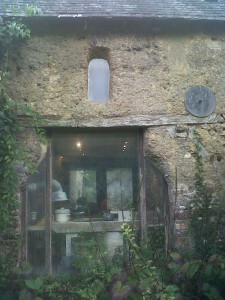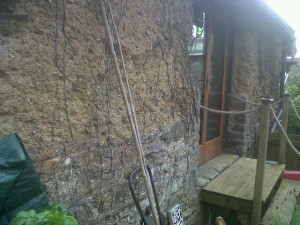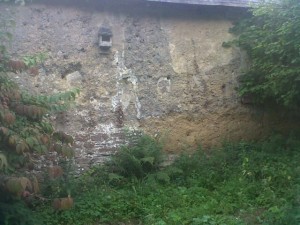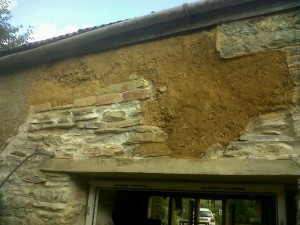23 Sep 2011
Back to the Old House: meetings with remarkable walls
 As part of last weekend’s Transition Town Totnes Open Eco-Homes weekend, I visited a house in Lower Allerton that was built in the 16th century, and which has recently been making many changes to reduce its environmental impact. As regular readers will know, I have done a fair bit of cob building in my time, and have often had to deal with the question “won’t it just wash away in the rain”, a question as infuriating to cob builders as Three Little Pigs jokes are to straw bale builders. The highlight for me, therefore, of the visit to Lower Allerton, was the 500 year-old cob walls.
As part of last weekend’s Transition Town Totnes Open Eco-Homes weekend, I visited a house in Lower Allerton that was built in the 16th century, and which has recently been making many changes to reduce its environmental impact. As regular readers will know, I have done a fair bit of cob building in my time, and have often had to deal with the question “won’t it just wash away in the rain”, a question as infuriating to cob builders as Three Little Pigs jokes are to straw bale builders. The highlight for me, therefore, of the visit to Lower Allerton, was the 500 year-old cob walls.
 While most of the buildings were built in stone, considerable sections were built using cob. Cob, for those of you who don’t know, is a building material which mixes clay-rich subsoil with water and straw to create a substance akin to plastercine which is then used to build load-bearing walls which set like rock, forming a monolithic structure which has incredible strength. It can be found in patches across the UK and Ireland, depending on the subsoil available. Often the houses around the village pond will be cob, as the pond marks the hole from which the subsoil had been dug (and the clay levels needed for cob would be sufficient for the pond to hold water without the need for a liner). Provided, as the old cob builders used to put it, it has “a good hat and a good pair of boots” it should last indefinitely.
While most of the buildings were built in stone, considerable sections were built using cob. Cob, for those of you who don’t know, is a building material which mixes clay-rich subsoil with water and straw to create a substance akin to plastercine which is then used to build load-bearing walls which set like rock, forming a monolithic structure which has incredible strength. It can be found in patches across the UK and Ireland, depending on the subsoil available. Often the houses around the village pond will be cob, as the pond marks the hole from which the subsoil had been dug (and the clay levels needed for cob would be sufficient for the pond to hold water without the need for a liner). Provided, as the old cob builders used to put it, it has “a good hat and a good pair of boots” it should last indefinitely.
What was so amazing to see with these ancient cob creations was not the fact that they had weathered the centuries so intact, that was no surprise. After all, I live in Devon which is the cob capital of the UK, and if you know what you’re looking for (rounded corners, stone plinths) you can see cob buildings all over the place, and most of them look like they’ve a few centuries under their belts. In these days where we’re already tearing down some of the buildings we built in the 1960s, and much of what we built in the 80s and 90s wasn’t exactly created with longevity in mind, running your hands over a 500 year old wall is a fantastic, and very thought-provoking experience.
 One of the beauties of building with cob is that it is a truly zero-waste building system. Any cob that isn’t used can be reworked and put into the next mix. Then, at the end of building’s life, the whole thing will simply return to the soil. No PVC soffits, no concrete, no plastic insulation, no plasterboard. What was amazing was how the wall had become much more than the wall, it had almost become its own ecosystem. There was a hole where bees were coming in and out of a nest they had made. There were plants growing up it. There were bird boxes on the wall. It felt alive, like a part of the whole place. I was reminded of one of my favourite quotes from the Victorian art critic John Ruskin, which I put into the Transition Handbook:
One of the beauties of building with cob is that it is a truly zero-waste building system. Any cob that isn’t used can be reworked and put into the next mix. Then, at the end of building’s life, the whole thing will simply return to the soil. No PVC soffits, no concrete, no plastic insulation, no plasterboard. What was amazing was how the wall had become much more than the wall, it had almost become its own ecosystem. There was a hole where bees were coming in and out of a nest they had made. There were plants growing up it. There were bird boxes on the wall. It felt alive, like a part of the whole place. I was reminded of one of my favourite quotes from the Victorian art critic John Ruskin, which I put into the Transition Handbook:
“When we build, let us think that we build for ever. Let it not be for present delight, nor for present use alone, let it be such work as our descendents will thank us for. And let us think, as we lay stone on stone, that a time is to come when those stones will be held sacred, because our hands have touched them, and that men will say as they look upon the labour and wrought substance of them, “see, this our fathers did for us?.
For indeed, the greatest glory of a building is not in its stones, nor in its gold, its glory is in its age, and in that deep sense of voicefulness, or stern watching, of mysterious sympathy, nay, even of approval or condemnation which we feel in walls that have long been washed by the passing waves of humanity. It is in that golden stain of time that we are to look for the real light and colour and preciousness of architecture?”
The walls were in need of a bit of TLC, some guttering would help with their longevity, as would a coat of lime render. There were some places where they had restored and patched with new cob, which looked great too (see right). There is something about these materials, which are rooted in the landscape around us, and how they create structure that seem to have grown out of the place, which I find deeply nourishing. Also, as an occasional cobber myself, to be able to touch the artistry of someone with the same skills, which have changed little over 500 years (although now you can do it with a digger which is fantastic!) gives a real sense of perspective. When we build, let us think that we build for ever”. Indeed.

nick
28 Sep 5:52am
I love the look of cob but tell me how much wood or gas are they burning to heat the place, or have they actually got insulated walls…and I understand you have thermal mass but its impact are over-estimated. I would like to see some nifty ways of insulating and building cob without doing a double skin insulated cob structure, the problem is you lose the whole asthetic of the finishes if you insulate one side or the other. I would expect the lifecycle energy of most cob buildings in cold climates like England would be greater than building insulated modern forms (and all the documentaries of them I’ve seen where they interview people in cobs they have big fires blaring constantly at night.